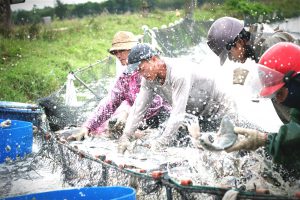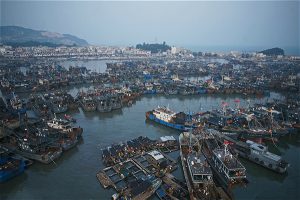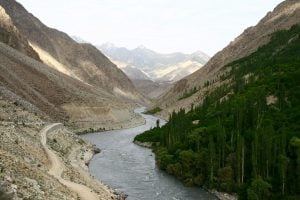Ten years ago, amateur tilapia farmers in China were able to dig a pond, fill it with fish, add antibiotics and chemicals, and then later sell the fish to numerous unregulated processors. In those early days, fish farming created a great economic boom for first-time aquaculture farmers, though with many costs to the environment.
Oversupplied and cheap, a majority of this tilapia landed in international markets – a notable 73% of the tilapia consumed in the US is still sourced from Chinese suppliers. Today however, with industry and consumer demand for safer and more sustainably sourced food, fish farmers are beginning to see the value in environmental protection as a cost-effective best practice.
With the world’s largest aquaculture sector, China’s vast collection of small scale and largely unregulated fish farms produce over 58 million tonnes annually, making up 60% of the world’s aquaculture production.
The overuse of fish antibiotics has contributed to immense water and soil pollution, international headlines on tainted seafood, and consumer anxiety over food safety. Marine fishery experts have also expressed concern that the use of wild-caught fishmeal for feeding China’s aquaculture farms is a growing contributor to today’s global overfishing crisis.
The latest new push on food safety directives by China’s central government has raised traceability of food sources as a policy priority, but with an incredibly complex and decentralised seafood industry, management and improvement efforts for China’s fish supply chain is more than just a challenging task. It will take an entire movement.
Following her lively presentation at the Wilson Center’s China Environment Forum, we sat down with Han Han, founder of China Blue, the first Chinese NGO committed to promoting sustainable fishery and aquaculture, to discuss the potential of turning the tide on China’s unsustainable fish supply chains.
In early 2015, China Blue launched China’s first seafood sustainability database, iFISH, that aims to help fish companies identify the environmental, social, and economic impacts of China’s most commonly farmed fish species.
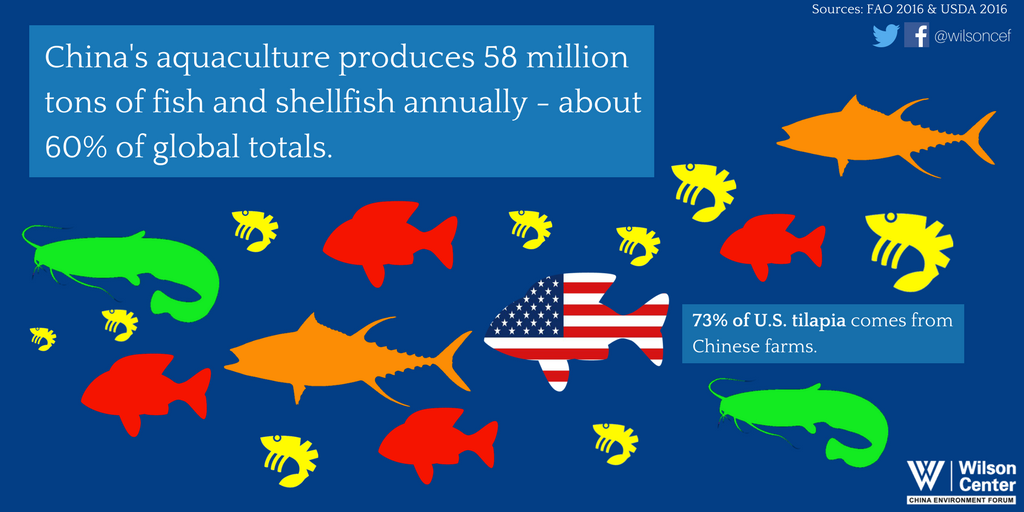
China’s aquaculture sector has expanded exponentially as China’s fish production has tripled in the last 20 years. What kind of sustainability challenges does this pose?
Han Han (HH): The largest sustainability challenges are the scale of production and complexity and diversity of the many species involved. Because fishing and fish farming consumes a lot of natural resources, such as water, there is a great impact on the marine ecosystem. If you follow the value chain, you must also follow the production of fishmeal, another part of natural resource consumption. How can we ensure we have clean water and healthy soil? How can we ensure that these basic elements will be sustained to support the continuous production of seafood on a massive scale?
Another challenge is certainly people and the economy – from fishermen to fish farmers, middlemen, managers, and factory workers – they are all part of this rapidly changing society in China. They will all be affected by changing business patterns and societal attitudes.
You’ve mentioned before that China’s seafood industry is fragmented and scattered in small scale production. What do you think are the most important areas of engagement in the supply chain?
HH: Because China is such a large country with a high degree of diversity, one needs to play it smart in a way that starts with something small but focuses on a significant result that will give the best chance for mobilisation. “Supply chain” is just one phrase, but it represents hundreds of different patterns and compositions.
Also, culture varies from place-to-place and for us, it has been about trying to identify the best-fit entry point depending on different factors. For example, mitten crab is a high-end product that is usually consumed by wealthier groups through a variety of sales channels, like e-commerce. When working with this product, we work on creating areas of engagement fit for this specific consumer group – wealthier or younger – by raising awareness and creating better traceability tools for this targeted supply chain.
Tell us a bit about the dangers of fishmeal made from wild-caught fish. How can China’s aquaculture stocks be fed sustainably?
HH: First of all, the majority of China’s aquaculture is mostly herbivore. As far as we know, dozens of commonly farmed species do not require high protein feeds.
The use of fishmeal for carnivore species is a smaller proportion of overall consumption. For those using fishmeal, Chinese fishmeal companies as well as nutritionists have invested a lot into looking for alternative sources of protein to wild-caught fishmeal replacements.
For example, using algae or aquaculture byproducts will help reduce the burden of wild fishmeal. These types of technologies have shown us that we are not in bad shape, even though the size of agriculture production is certainly daunting. We see that the recycling of nutrient waste could also improve these systems, and overall we hope to see these new technologies replace outdated systems.
Tell us about China Blue’s new project, iFish. How does it work and who have been your most enthusiastic partners?
HH: iFISH is China’s first seafood sustainability database, still very young and developing.
It covers a little over 50 of the most commonly consumed species. Our data collection is still growing, but we see potential in expanding data sharing capacities and collaboration with government institutes and industry associations.
In terms of partners, our most enthusiastic partner has been Disney, which has been a leader and pioneer in this field. We really appreciate their courage to be the first ones in China’s market to attempt this. We are also very excited to work with CAPPMA (China Aquatic Product Processing Marketing Association) and the retailers association, CCFA. These are all important partners for us, and we hope we can expand partnerships to gain more technical and policy influence.
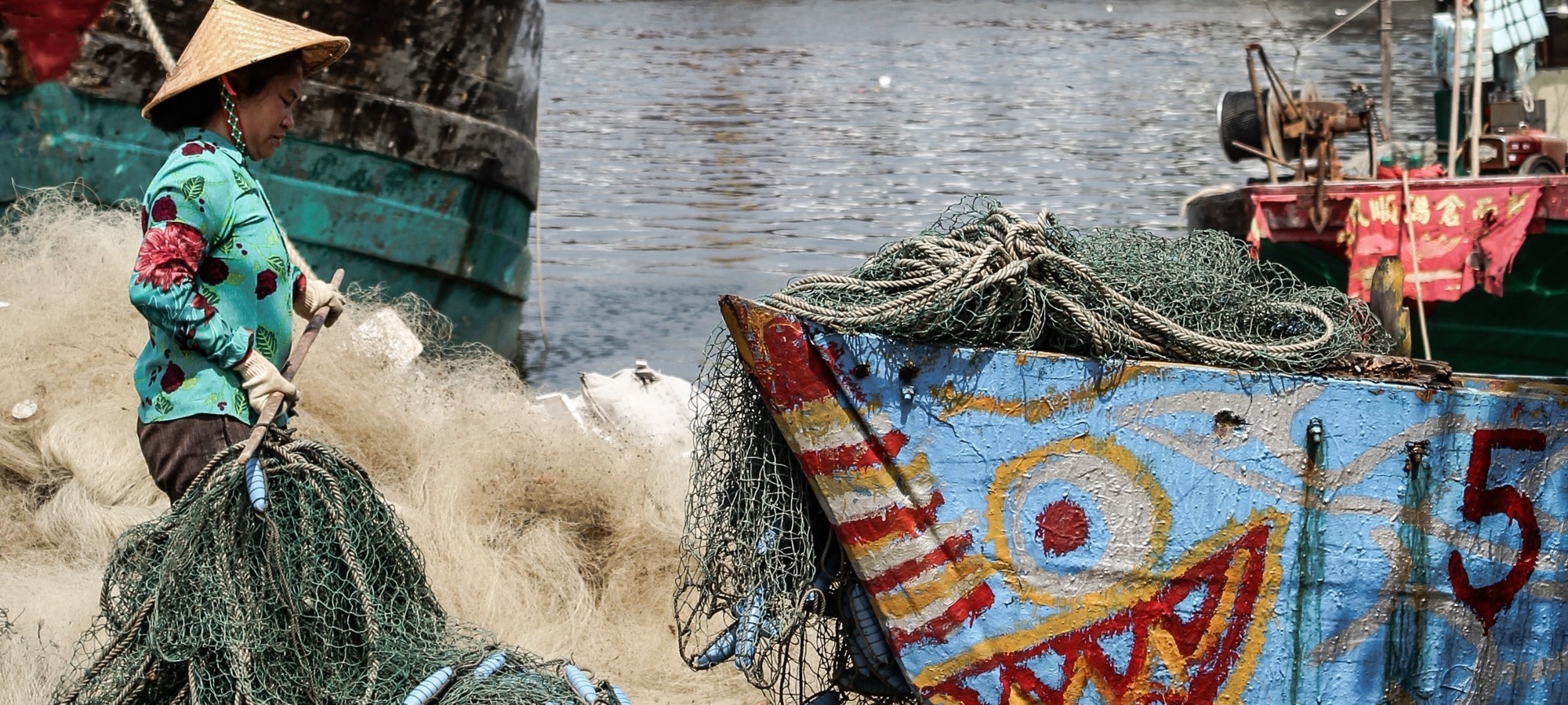
Fish farmers are beginning to see value in environmental protection (Image by Steve Rocliffe)
Based on China Blue’s experiences, what should we be focusing on when promoting seafood sustainability?
HH: China Blue’s iFISH tool focuses on improving business-to-business relations on the producer and supplier side. Working with producers in past years, we have definitely seen a change. Producers have come to see how these best practices can be beneficial for them, as it helps reduce disease rates and save costs in the long run.
For the consumer side, we have only just started, so the perception of “sustainable seafood” hasn’t caught up with consumers quite yet. But both have a very important role in the movement, and we have seen concerns over food safety and quality play a bigger role in shaping consumer attitudes towards sustainable seafood.
Why start with improving transparency and traceability?
HH: Transparency is the foundation for any further collaboration or improvements. Without transparency, it is difficult for anyone to make suggestions for future improvements. Traceability is also something that has always been an issue for all kinds of supply chains. Food is definitely important because of the concern over food safety, and historically, China has always operated seafood through small scale production. It has relied on middle agents who are very unpredictable, constantly moving around and switching – these types of fluctuations have really added a lot of challenges to traceability.
Could public participation and citizen science play a bigger role in improving China’s fish supply chain sustainability?
HH: Firstly, if the consumers don’t care, then there is very little motivation for the business side to care. If everyone demands more information about where the food comes from and what its environmental footprint is, if more people ask these questions, then a pressure will build up for retailers to address these issues.
